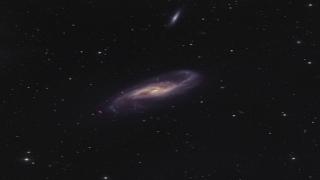Bibcode
Galaz, Gaspar; González-López, Jorge; Guzmán, Viviana; Messias, Hugo; Junais; Boissier, Samuel; Epinat, Benoît; Weilbacher, Peter M.; Puzia, Thomas; Johnston, Evelyn J.; Amram, Philippe; Frayer, David; Blaña, Matìas; Howk, J. Christopher; Berg, Michelle; Bustos-Espinoza, Roy; Muñoz-Mateos, Juan Carlos; Cortés, Paulo; García-Appadoo, Diego; Joachimi, Katerine
Bibliographical reference
The Astrophysical Journal
Advertised on:
11
2024
Journal
Citations
6
Refereed citations
5
Description
After over three decades of unsuccessful attempts, we report the first detection of molecular gas emission in Malin 1, the largest spiral galaxy observed to date, and one of the most iconic giant low surface brightness galaxies. Using Atacama Large Millimeter/submillimeter Array, we detect significant 12CO (J = 1–0) emission in the galaxy's central region and tentatively identify CO emission across three regions on the disk. These observations allow for a better estimate of the H2 mass and molecular gas mass surface density, both of which are remarkably low given the galaxy's scale. By integrating data on its H I mass, we derive a very low molecular-to-atomic gas mass ratio. Overall, our results highlight the minimal presence of molecular gas in Malin 1, contrasting sharply with its extensive, homogeneous atomic gas reservoir. For the first time, we position Malin 1 on the Kennicutt–Schmidt diagram, where it falls below the main sequence for normal spirals, consistent with previous upper limits but now with more accurate figures. These findings are crucial for constraining our understanding of star formation processes in environments characterized by extremely low molecular gas densities and for refining models of galaxy formation, thereby improving predictions concerning the formation, evolution, and distribution of these giant, elusive galaxies.
Related projects

Spiral Galaxies: Evolution and Consequences
Our small group is well known and respected internationally for our innovative and important work on various aspects of the structure and evolution of nearby spiral galaxies. We primarily use observations at various wavelengths, exploiting synergies that allow us to answer the most pertinent questions relating to what the main properties of
Johan Hendrik
Knapen Koelstra